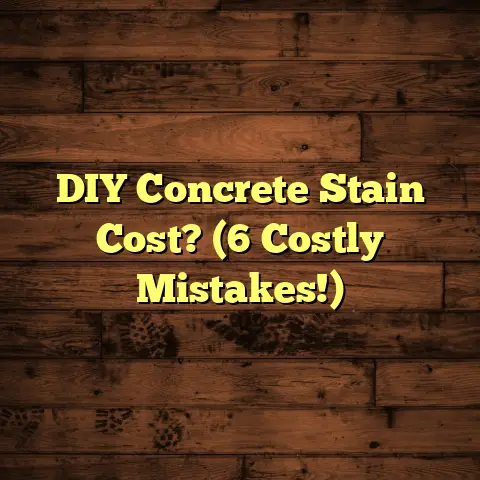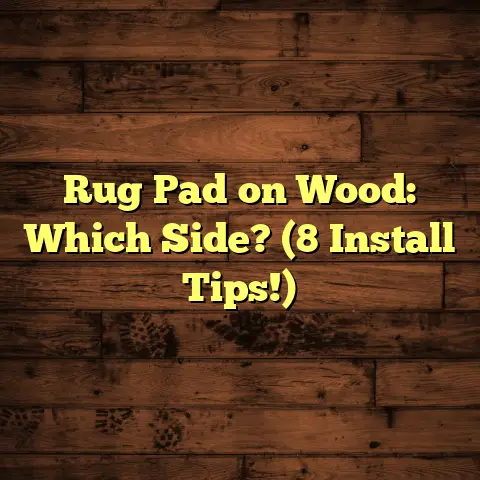Fix Slippery Bathroom Tile (3 DIY Solutions Now!)
Picture this: It’s Saturday morning, you’ve just stepped out of a hot shower, feeling amazing.
Then BAM!
Your foot slips on that glossy
bathroom tile.
Heart in your throat, right?
You grab the towel rack just in time, but
the fear?
That sticks with you.
Those beautiful tiles suddenly feel like a skating rink. Sound familiar?
Slippery bathroom tiles are a super
common problem.
Especially if you’ve
got kids, older folks, or, you know, just
value not falling on your butt!
The good news?
You don’t have to live
in fear of your bathroom floor.
I’ve been
a flooring contractor for over 15 years,
and I’ve seen it all.
I’m going to share my top 3 DIY solutions
to tackle those slippery tiles head-on.
Let’s dive in!
Solution 1: Applying Non-Slip Treatments
Okay, first up: non-slip treatments.
These
are designed specifically for tile surfaces.
Think of them as a grip upgrade for your floor.
What Are Non-Slip Treatments?
These treatments come in a few forms:
- Anti-slip Sprays: Quick and easy to apply.
They create a textured surface for better grip. - Coatings: These are a bit more durable than
sprays.
They form a protective layer that increases friction. - Chemical Etches: These actually change the
surface of the tile, creating microscopic
indentations that improve traction.
(Use with caution!)
How Do They Work?
Basically, they increase the coefficient of friction
(COF) on your tile.
COF measures how much
force it takes to slide an object across a surface.
Higher COF = less slippery.
According to the American Society for Testing
and Materials (ASTM), a COF of 0.5 or higher
is considered safe for level surfaces.
1
Step-by-Step Application
Alright, let’s get practical. Here’s how to apply a non-slip treatment like a pro:
Prep is Key: Clean the tile thoroughly.
I mean really thoroughly.
Use a degreasing cleaner to remove any soap scum, dirt, or oils.
Rinse well and let it dry completely.
(Trust me, this step is crucial!)Test Patch: Always, always test the treatment in a small, inconspicuous area first.
This ensures it doesn’t discolor or damage the tile.
Let it dry completely before proceeding.Application: Follow the manufacturer’s instructions exactly.
This usually involves spraying, rolling, or brushing the treatment onto the tile.
Apply evenly and avoid pooling.Drying Time: Let the treatment dry for the recommended time.
This can range from a few hours to 24 hours or more.
Keep the bathroom ventilated during this time.Final Rinse: Some treatments require a final rinse after drying.
Again, follow the instructions carefully.
My Pro Tip: Use painter’s tape to protect
your grout lines.
Some treatments can stain or
discolor grout.
Choosing the Right Product
Not all tiles are created equal, so neither are
non-slip treatments.
Here’s what to consider:
- Tile Material: Some treatments are better
suited for certain materials like porcelain,
ceramic, or natural stone.
Read the product label carefully! - Finish: Glossy tiles will generally require a more aggressive treatment than matte tiles.
- Foot Traffic: A high-traffic bathroom will need a more durable treatment than a guest bathroom.
Longevity: How long will it last?
Most treatments last anywhere from 6 months to
2 years, depending on the product and the
amount of traffic.
You’ll know it’s time to
reapply when you start to feel the tile getting
slippery again.
Example: I once had a client with beautiful
slate tiles in their bathroom.
They were gorgeous,
but incredibly slippery when wet.
I recommended
a penetrating sealer with a non-slip additive.
It enhanced the natural color of the slate while
significantly improving traction.
They were
thrilled!
Solution 2: Using Anti-Slip Mats and Rugs
Okay, let’s talk about the easiest and most versatile solution: anti-slip mats and rugs.
Why Mats and Rugs?
- Instant Grip: They provide immediate traction where you need it most.
- Style Boost: You can find mats and rugs in a huge variety of colors, patterns, and styles to match your bathroom décor.
- Easy to Clean: Most mats and rugs are machine washable, making them super easy to maintain.
Types of Anti-Slip Mats and Rugs
- Adhesive Mats: These have a sticky backing
that adheres directly to the tile.
They’re great for high-traffic areas like in front of the shower or sink. - Suction Cup Mats: These use suction cups
to grip the tile.
They’re ideal for inside the shower or tub. - Non-Slip Rugs with Backing: These rugs have
a rubber or latex backing that prevents them
from sliding around.
They’re perfect for adding a touch of style and safety to your bathroom.
Choosing the Right Size and Style
- Size Matters: Measure your bathroom space
carefully to determine the right size mat or
rug.
You want it to cover the areas where you’re most likely to slip, but not be so large that it becomes a tripping hazard. - Consider Your Layout: If you have a small
bathroom, a runner rug in front of the sink or
shower might be all you need.
If you have a larger bathroom, you might want to use multiple mats or a larger area rug. - Match Your Décor: Choose mats and rugs that
complement your bathroom’s style and color
scheme.
You can find everything from simple, functional mats to luxurious, decorative rugs.
Securing Your Mats
Even anti-slip mats can slip if they’re not
properly secured.
Here are a few tips:
- Clean the Tile: Make sure the tile is clean and dry before applying the mat.
- Use Rug Grippers: For extra security, use
rug grippers underneath your mats and rugs.
These are small, adhesive pads that attach to the rug and the floor to prevent slipping. - Check Regularly: Check your mats and rugs
regularly to make sure they’re still securely
in place.
Re-adjust or replace them as needed.
Maintaining Your Mats
To keep your mats and rugs in good condition and prevent them from becoming slippery, follow these tips:
- Wash Regularly: Wash your mats and rugs
according to the manufacturer’s instructions.
This will remove dirt, soap scum, and other debris that can make them slippery. - Dry Thoroughly: Make sure your mats and
rugs are completely dry before putting them
back on the floor.
Damp mats can attract mold and mildew, which can make them slippery. - Replace When Worn: Over time, your mats
and rugs will wear out and lose their grip.
Replace them when they start to show signs of wear and tear.
Pro Tip: I like to use a combination of adhesive mats in high-traffic areas and a decorative rug with a non-slip backing to add both safety and style to my clients’ bathrooms.
Solution 3: DIY Textured Tile Treatments
Alright, let’s get a little more creative!
If you’re feeling adventurous, you can actually
add texture to your tiles yourself.
Why Texture Your Tiles?
- Permanent Solution: Unlike mats and rugs, textured tile treatments are a more permanent solution to slippery tiles.
- Customizable: You can customize the amount of texture to suit your needs and preferences.
- Cost-Effective: DIY textured tile treatments can be a relatively inexpensive way to improve safety in your bathroom.
Important Note: Before you start, it’s
crucial to understand that these methods can
potentially alter the appearance of your tiles.
Always test in an inconspicuous area first!
DIY Texturing Methods
- Sandpaper: Lightly sanding your tiles can
create a slightly rougher surface that improves
traction.
Use a fine-grit sandpaper (220 grit or higher) and sand in a circular motion.
Be careful not to scratch the tiles too deeply. - Non-Slip Tape: This is a quick and easy
way to add texture to your tiles.
Simply cut the tape to the desired size and shape and apply it to the tiles.
Non-slip tape is available in a variety of colors and textures. - Textured Paint: You can also use textured
paint to add grip to your tiles.
Choose a paint that is specifically designed for use on tile and follow the manufacturer’s instructions carefully.
Step-by-Step Instructions
Sandpaper:
- Clean the Tile: Clean the tile thoroughly and let it dry completely.
- Sand Lightly: Use fine-grit sandpaper to lightly sand the tile in a circular motion.
- Rinse and Dry: Rinse the tile with clean water and let it dry completely.
- Test the Grip: Test the grip of the tile to
make sure it’s improved.
If not, you can sand it a little more.
Non-Slip Tape:
- Clean the Tile: Clean the tile thoroughly and let it dry completely.
- Cut the Tape: Cut the non-slip tape to the desired size and shape.
- Apply the Tape: Peel off the backing and apply the tape to the tile.
- Press Firmly: Press the tape firmly onto the tile to ensure good adhesion.
Textured Paint:
- Clean the Tile: Clean the tile thoroughly and let it dry completely.
- Prime the Tile: Apply a primer that is specifically designed for use on tile.
- Apply the Paint: Apply the textured paint according to the manufacturer’s instructions.
- Let it Dry: Let the paint dry completely before using the bathroom.
Considerations
- Tile Type: Some tiles are more porous than others, which can affect how well the textured treatment adheres.
- Aesthetics: Keep in mind that these methods
can alter the appearance of your tiles.
Consider how the textured treatment will look with your existing bathroom décor. - Durability: Some textured treatments are
more durable than others.
Consider how much traffic your bathroom gets when choosing a textured treatment.
My Experience: I once had a client who was
on a tight budget but desperately needed to
improve the safety of their bathroom.
We used
non-slip tape in a subtle, geometric pattern to
add grip to their tiles.
It was a cost-effective
and stylish solution that they loved!
Conclusion: Encouraging Safety and Style
So, there you have it!
Three DIY solutions to
transform your slippery bathroom tiles into a
safe and stylish haven.
Remember, safety doesn’t have to come at the
expense of style.
With a little effort and
creativity, you can create a bathroom that is
both beautiful and functional.
Don’t wait until you or a loved one slips and
falls.
Take action today and make your bathroom
a safer place for everyone.
Which solution are you most excited to try?
Let me know in the comments below!
Footnotes
1 ASTM International.
(2021).
Standard Test Method for Static Coefficient of Friction of Ceramic Tile and Other Like Surfaces by the Horizontal Dynamometer Pull-Meter Method.
ASTM C1028-07e1.
https://www.astm.org/c1028-07e1.html





